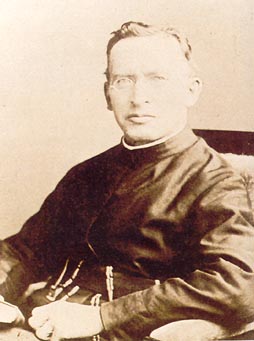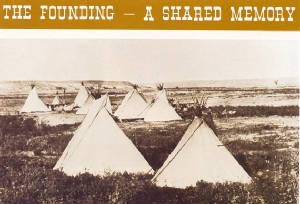
St. Stephens Mission, late 1800s
The Jesuits who founded numerous Missions among the Plains Indians in the 1880’s, including St. Stephens, were aware of the changed circumstances brought about by the reservation system. The key to the Government’s desire for Indian assimilation was by the process of education. Chief Black Coal of the Northern Arapaho spoke of this as early as 1878 when he said:
“This (land in southern Wyoming) was the country of my fathers, now dead and dying. We love our children. We very much want a good school house, and a good man to teach our children to read your language, that they may grow up to be intelligent men and women, like the children of the White man. And then, when Sunday comes, we would be glad of some good man to teach our children about the Great Spirit.”
Bishop James O’Connor, the Catholic Bishop of Omaha, whose diocese then included what would soon (1890) be the new state of Wyoming, heard that the Federal Government was planning a school for Indian children on the Wind River Reservation at Fort Washakie, the Agency. O’Connor had already collected $5,000 to be used in some way for the Indian people of the Reservation and, on hearing of the school plans, the Bishop offered the money for fitting the interior of the new school building, if the government would accept the Church’s offer and let the Bishop operate the school. O’Connor then made arrangements with the Buffalo, New York Mission of the Society of Jesus to send Father John J. Jutz, a Germain Jesuit, to found the new mission.
Father Jutz arrived at Lander, a town on the south-western edge of the Reservation, sometime during the week of April 20, 1884, only to find to his dismay that the Agency had already assigned the school, which was to operate principally among the Shoshoni, to the famous Welsh Episcopal minister, the Reverend John Roberts. It was then that Jutz heard that the Northern Arapaho lived at the far east end of the Reservation and might be open to the idea of a school in their area, having already sent some of their children to schools in the East.
Jutz arrived in May, 1884 at Black Coal’s camp near the confluence of the Little and Big Wind Rivers (about four miles from the modern city of Riverton). Father Jutz was soon joined by Jesuit Brother Ursis Nunlist who came to help build the new mission. In a letter sent East, dated August 12, 1884, Jutz noted that he and Brother Nunlist had commenced work on a “a school and dwelling house,” the latter being a four room 24 by 24 foot building which served as chapel, sleeping quarters, kitchen, reception room, and workshop…the beginnings of St. Stephens Indian Mission.

Reverend John J. Jutz, S.J.

Black Coal’s Camp – Courtesy of the Smithsonian Institute

This photo, taken in 1912, shows the original three major Mission buildings. The building on the left was the church, boy’s dormitory, gymnasium and Jesuit priests house. This structure was destroyed by fire in 1928. The present church at St. Stephens stands on this same spot. The building on the right was the Franciscan sister’s convent and girl’s dormitory. It too is now gone. In 2003, the building was demolished due to safety problems and the high cost of restoration. The less noticable structure in the center is the only one that remains in use today. This building, nown know as Sister Incarnata Hall, has been utilized for over 100 years for many programs and housed numerous projects. As times changed and other needs developed the space of this building was converted into whatever was needed and is still participating in that function.